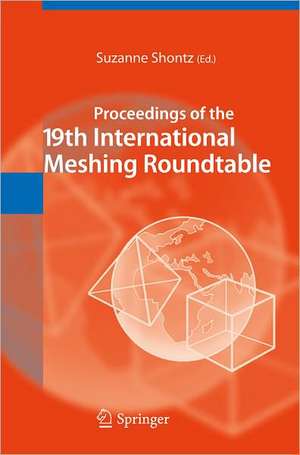Proceedings of the 19th International Meshing Roundtable
Editat de Suzanne Shontzen Limba Engleză Hardback – 27 sep 2010
| Toate formatele și edițiile | Preț | Express |
|---|---|---|
| Paperback (1) | 1278.54 lei 43-57 zile | |
| Springer Berlin, Heidelberg – 3 dec 2014 | 1278.54 lei 43-57 zile | |
| Hardback (1) | 1283.64 lei 43-57 zile | |
| Springer Berlin, Heidelberg – 27 sep 2010 | 1283.64 lei 43-57 zile |
Preț: 1283.64 lei
Preț vechi: 1604.55 lei
-20% Nou
Puncte Express: 1925
Preț estimativ în valută:
245.63€ • 257.10$ • 204.44£
245.63€ • 257.10$ • 204.44£
Carte tipărită la comandă
Livrare economică 31 martie-14 aprilie
Preluare comenzi: 021 569.72.76
Specificații
ISBN-13: 9783642154133
ISBN-10: 3642154131
Pagini: 510
Ilustrații: IX, 424 p.
Dimensiuni: 155 x 235 x 33 mm
Greutate: 0.75 kg
Ediția:2010
Editura: Springer Berlin, Heidelberg
Colecția Springer
Locul publicării:Berlin, Heidelberg, Germany
ISBN-10: 3642154131
Pagini: 510
Ilustrații: IX, 424 p.
Dimensiuni: 155 x 235 x 33 mm
Greutate: 0.75 kg
Ediția:2010
Editura: Springer Berlin, Heidelberg
Colecția Springer
Locul publicării:Berlin, Heidelberg, Germany
Public țintă
ResearchDescriere
The papers in this volume were selected for presentation at the 19th International Meshing Roundtable (IMR), held October 3–6, 2010 in Chattanooga, Tennessee, USA. The conference was started by Sandia National Laboratories in 1992 as a small meeting of organizations striving to establish a common focus for research and development in the field of mesh generation. Now after 19 consecutive years, the International Meshing Roundtable has become recognized as an international focal point annually attended by researchers and developers from dozens of co- tries around the world. The 19th International Meshing Roundtable consists of technical presentations from contributed papers, research notes, keynote and invited talks, short course presentations, and a poster session and competition. The Program Committee would like to express its appreciation to all who participate to make the IMR a successful and enriching experience. The papers in these proceedings were selected by the Program Committee from among numerous submissions. Based on input from peer reviews, the committee selected these papers for their perceived quality, originality, and appropriateness to the theme of the International Meshing Roundtable. We would like to thank all who submitted papers. We would also like to thank the colleagues who provided reviews of the submitted papers. The names of the reviewers are acknowledged in the following pages. We extend special thanks to Jacqueline Hunter for her time and effort to make the 19th IMR another outstanding conference.
Cuprins
Session 1A, Surface Meshing.- Hexagon-Based All-Quadrilateral Mesh Generation with Guaranteed Angle Bounds.- Q-TRAN: A New Approach to Transform Triangular Meshes into Quadrilateral Meshes Locally.- Mesh Construction with Prescribed Properties Near Boundary.- A Transfinite Meshing Approach for Body-In-White Analyses.- Session 2A, Optimization.- Introducing the Target-Matrix Paradigm for Mesh Optimization via Node-Movement.- An Analytical Framework for Quadrilateral Surface Mesh Improvement with an Underlying Triangulated Surface Definition.- Efficient Solution of Elliptic Partial Differential Equations via Effective Combination of Mesh Quality Metrics, Preconditioners, and Sparse Linear Solvers.- Virtual Control Volumes for Two-Dimensional Unstructured Elliptic Smoothing.- Session 2B, Surface Reconstruction and Repair.- Reconstructing High-Order Surfaces for Meshing.- Simple Method for Constructing NURBS Surfaces from Unorganized Points.- Sealing Faceted Surfaces to Achieve Watertight CAD Models.- A Metric for Automatic Hole Characterization.- Session 3A, Hex Meshing.- Receding Front Method: A New Approach Applied to Generate Hexahedral Meshes of Outer Domains.- EBMesh: An Embedded Boundary Meshing Tool.- Sharp Feature Preservation in Octree-Based Hexahedral Mesh Generation for CAD Assembly Models.- Pen-Based User Interface for Geometric Decomposition for Hexahedral Mesh Generation.- Session 6A, Adaptive.- Particle Systems for Adaptive, Isotropic Meshing of CAD Models.- A Study on Using Hierarchical Basis Error Estimates in Anisotropic Mesh Adaptation for the Finite Element Method.- Bisection-Based Triangulations of Nested Hypercubic Meshes.- Optimizing Voronoi Diagrams for Polygonal Finite Element Computations.- Session 6B, Applications.- Creating Geometry and Mesh Models for Nuclear Reactor Core Geometries Using a Lattice Hierarchy-Based Approach.- Multi-tissue Mesh Generation for Brain Images.- A Toolkit for Parallel Overset Grid Assembly Targeting Large-Scale Moving Body Aerodynamic Simulations.- A Dimension-Independent Data Structure for Simplicial Complexes.
Textul de pe ultima copertă
This volume contains the articles presented at the 19th International Meshing Roundtable (IMR) organized, in part, by Sandia National Laboratories and held October 3-6, 2010 in Chattanooga, Tennessee, USA. The first IMR was held in 1992, and the conference has been held annually since. Each year the IMR brings together researchers, developers, and application experts, from a variety of disciplines, to present and discuss ideas on mesh generation and related topics. The topics covered by the IMR have applications in numerical analysis, computational geometry, computer graphics, as well as other areas, and the presentations describe novel work ranging from theory to application.
Caracteristici
Recent results of mesh generation and adaptation which has applications to finite element simulation Proceedings of the prestigious International Meshing Roundtable conference organized by Sandia National Laboratories Introducing theoretical and novel ideas with practical potential as well as technical applications from industrial researchers, bringing together renown specialists from engineering, computer science and mathematics
















